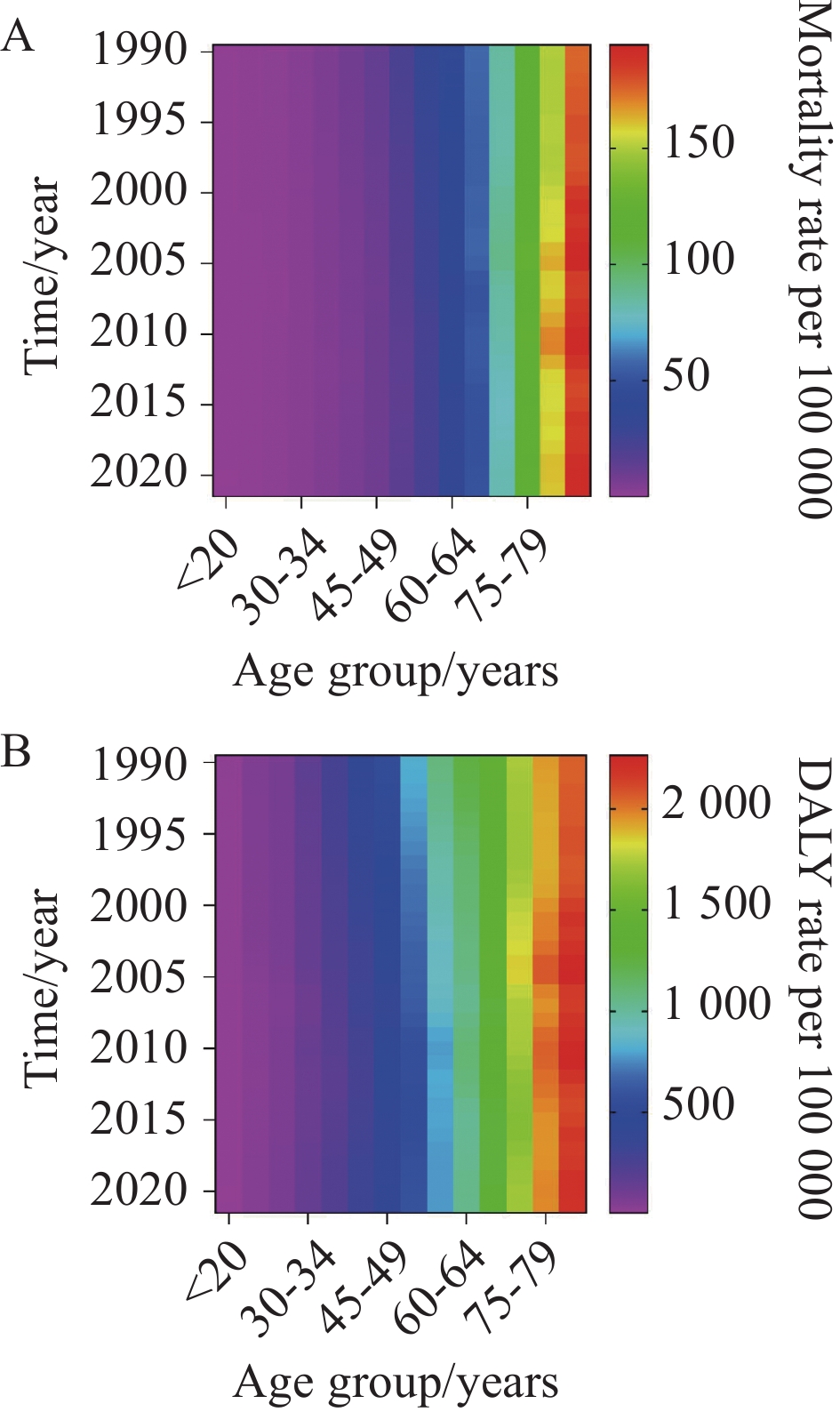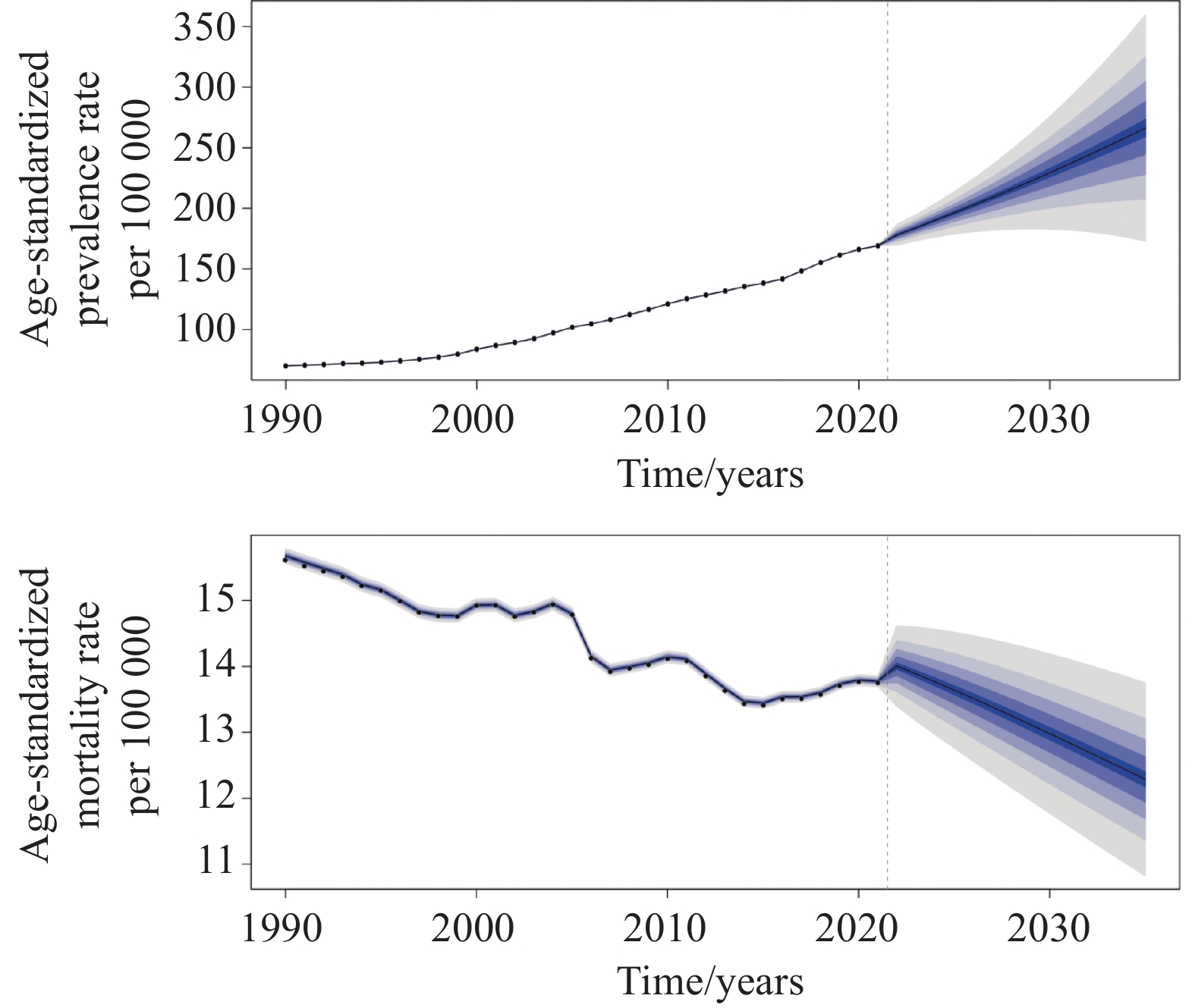Variation Tendency and Prediction of Colorectal Cancer Burden Among Chinese Population from 1990 to 2021
-
摘要:目的
分析中国居民1990—2021年结直肠癌(CRC)疾病负担现状与趋势。
方法收集1990—2021年全球疾病负担数据库中国、亚洲和全球居民结直肠癌疾病负担的相关数据进行描述性分析,利用年龄-时期-队列模型估算年龄、时期和队列对结直肠癌死亡所产生的影响,并预测疾病负担变化趋势。
结果2021年中国CRC年龄标化死亡率、患病率和DALY率均高于全球和亚洲地区,1990—2021年年估计变化百分比分别为−0.49%(95%CI: −0.55%~ −0.43%)、3.17%(95%CI: 3.03%~3.31%)和−0.62%(95%CI: −0.71%~ −0.54%)。高社会人口学指数(SDI)和中高SDI地区CRC标化死亡率、标化DALY率降幅明显,但仍高于全球其他地区。中国人群、男性和女性人群CRC死亡率随年龄增长呈上升趋势,且男性结直肠癌死亡率增长逐渐大于女性。以2002—2006年时期组为对照组(RR=1),女性CRC死亡风险的时期效应在2004年前高于男性和总人群,此后呈明显下降趋势。以1957年出生队列组为对照组(RR=1),中国人群、男性和女性CRC死亡风险的队列效应随出生队列的推移总体均呈下降趋势。预测结果显示,2035年中国居民CRC标化患病率为267.21/10万,标化死亡率为12.29/10万。
结论1990—2021年中国CRC年龄标化死亡率和DALY率整体均呈下降趋势,标化患病率呈增长趋势,提示政府需构建全方位、多层次的CRC防控网络。
Abstract:ObjectiveTo examine the current status and trends of colorectal cancer (CRC) burden among Chinese residents from 1990 to 2021.
MethodsData on CRC burden in China, Asia, and the global population from 1990 to 2021 were retrieved from the Global Burden of Disease database for descriptive analysis. An age-period-cohort model was employed to estimate the effects of age, period, and cohort on CRC mortality and to forecast changes in disease burden.
ResultsIn 2021, China’s age-standardized mortality rate, prevalence rate, and DALY rate for CRC were higher than global and Asian averages. The estimated annual percentage changes (EAPC) from 1990 to 2021 were −0.49% (95%CI: −0.55% to −0.43%) for mortality, 3.17% (95%CI: 3.03%−3.31%) for prevalence, and −0.62% (95%CI: −0.71% to −0.54%) for DALYs. Areas with high and medium-high sociodemographic indexes (SDIs) showed significant decreases in standardized mortality and DALY rates, but these rates remained higher compared with other regions. CRC mortality increased with age in the Chinese population, more prominently in males than in females. Using the 2002–2006 period as a reference (RR=1), the period effect on CRC mortality risk for women was higher than that for men until 2004, after which it declined considerably. With the 1957 birth cohort as a reference (RR=1), CRC mortality risk generally decreased across subsequent birth cohorts. Predictions indicate that by 2035, the standardized prevalence rate will be 267.21 per 100 000, and the standardized mortality rate will be 12.29 per 100 000.
ConclusionFrom 1990 to 2021, China’s age-standardized CRC mortality and DALY rates have decreased, while the standardized prevalence rate has increased. These findings suggest the government to establish a comprehensive multi-level CRC prevention network.
-
Key words:
- Colorectal cancer /
- Chinese population /
- Burden of disease /
- Forecasting
-
0 引言
结直肠癌(Colorectal cancer, CRC)作为全球范围内一种常见的恶性肿瘤,近年来其发病率在多个国家呈增长趋势[1]。据统计,2022年全球新增结直肠癌患者数量高达193万例,并导致近93万人死亡[2]。2022年结直肠癌在我国恶性肿瘤中死亡顺位为第四位,死亡率为8.62/10万[3]。本研究基于全球疾病负担(Global Burden of Disease 2021, GBD 2021)数据库,分析和预测中国结直肠癌疾病负担现状及变化趋势,为制定精准防控策略和措施提供依据。
1 资料与方法
1.1 资料来源
资料来源于GBD 2021数据库。本研究收集1990—2021年中国、亚洲和全球居民结直肠癌疾病负担的相关数据,包括患病率、死亡率和伤残调整寿命年(Disability adjusted life years, DALY)率等指标,采用《疾病和有关健康问题的国际统计分类》ICD-10编码进行分类,编码为C18~C21.9、D01.0~D01.3、D12~D12.9、D37.3~D37.5、Z12.1~Z12.13、Z85.03~Z85.048 和Z86.010。
1.2 研究方法
针对1990—2021年中国、亚洲和全球居民结直肠癌疾病负担的相关数据,采用患病率、死亡率和DALY率等指标进行描述性分析,利用年龄-时期-队列(Age-period-cohort, APC)模型估算年龄、时期和队列对结直肠癌死亡所产生的影响,并运用贝叶斯年龄-时期-队列(BAPC)模型预测中国结直肠癌疾病负担变化趋势。
1.3 指标解释
社会人口学指数(Socio-demographic index, SDI)是一个国家或地区发展状况的综合指标。取值范围为0~1,数值越大代表该国家(或地区)的发展状况越好。GBD 2021将国家按照SDI分为低、中低、中、中高、高5个发展等级[4]。
年估计变化百分比(Estimated annual percent change, EAPC)是通过拟合线性回归模型来评估率的时间变化趋势。如采用对数变换后的年度率(死亡率、DALY率)作为因变量,时间(年份)作为自变量,公式可表达为:EAPC=100*(exp(β)−1)。EAPC及其95%CI<0代表该指标在随时间增长整体呈下降趋势,EAPC越小代表下降趋势越明显,反之则表示升高。
1.4 统计学方法
采用Excel 2019软件进行数据整理,分析指标包括患病率、死亡率和DALY率,其各标化率采用GBD 2021全球标准人口结构进行标化;EAPC和BAPC预测模型采用R 4.3.0软件计算和构建,利用GraphPad Prism 9.0软件绘图;APC模型采用美国国家癌症研究所基于R语言研发的网页工具(https://analysistools.nci.nih.gov/apc/)进行分析[5]。使用一般线性模型检验时期/出生队列之间的相互作用效果,可估计函数采用Wald χ2检验,检验水准α=0.05。结果指标包括净变化值、纵向年龄趋势、横断面年龄趋势、时期RR、队列RR。
2 结果
2.1 中国与亚洲、全球CRC疾病负担现状比较
2021年中国CRC年龄标化死亡率、患病率和DALY率均高于全球和亚洲地区,1990—2021年CRC年龄标化死亡率、患病率和DALY率的EAPC分别为−0.49%(95%CI: −0.55%~ −0.43%)、3.17%(95%CI: 3.03%~3.31%)和−0.62%(95%CI: −0.71%~ −0.54%);1990年和2021年中国男性CRC年龄标化死亡率、患病率和DALY率均大于女性,1990—2021年女性年龄标化死亡率和标化DALY率呈下降趋势,见表1。
表 1 1990—2021年中国、亚洲和全球居民CRC疾病负担比较Table 1 Comparison of CRC burden in China, Asia and the global population, 1990–2021Std. mortality rate/100 000(95%UI) 1990−2021
EAPCs(95%CI)Std. prevalence rate/100 000 (95%UI) 1990−2021
EAPCs(95%CI)Std. DALY rate/100 000 (95%UI) 1990−2021
EAPCs(95%CI)1990 2021 1990 2021 1990 2021 Region Global 15.56
(14.49−16.31)12.40
(11.24−13.31)−0.81
(−0.84− −0.77)108.25
(103.29−112.75)134.84
(124.21−144.77)0.74
(0.68−0.79)357.33
(336.62−375.74)283.24
(263.11−303.33)−0.83
(−0.87− −0.80)Asia 11.95
(10.80−13.08)11.26
(9.92−12.55)−0.26
(−0.29− −0.23)69.90
(60.62−79.84)119.35
(105.04−134.59)1.87
(1.84−1.92)295.96
(267.44−326.31)262.34
(232.30−294.71)−0.47
(−0.51− −0.43)China 15.49
(13.43−17.71)13.64
(11.09−16.31)−0.49
(−0.55− −0.43)68.63
(63.53−73.85)168.62
(136.58−203.05)3.17
(3.03−3.31)390.63
(333.24−448.92)331.73
(267.78−400.70)−0.62
(−0.71− −0.54)Gender Male 18.56
(15.05−22.07)18.95
(14.65−24.35)0.10
(0.04−0.16)79.52
(65.19−94.85)219.30
(169.59−280.99)3.76
(3.58−3.93)454.10
(360.35−547.99)452.83
(349.19−585.28)0.02
(−0.05−0.09)Female 13.23
(10.70−16.02)9.34
(7.10−11.88)−1.38
(−1.49− −1.26)61.15
(49.93−73.74)120.03
(92.27−153.21)2.29
(2.18−2.40)334.19
(263.37−410.15)220.01
(167.51−282.02)−1.63
(−1.77− −1.50)Note: CRC: colorectal cancer. 根据中国不同年龄段CRC死亡率、DALY率热图结果显示,1990—2021年间随着年龄的增长,其死亡率和DALY率均增高,随着时间推移各年龄段CRC死亡率和DALY率未呈明显变化趋势,见图1。
结果显示,1990—2021年间中国居民CRC标化死亡率、标化DALY率总体呈下降趋势,但仍高于全球和亚洲地区,并在2015年后略呈上升趋势。高SDI和中高SDI地区CRC标化死亡率、标化DALY率降幅明显,但仍高于全球其他地区,低SDI和中低SDI地区CRC标化死亡率、标化DALY率明显低于全球其他地区,且随时间变化呈平稳趋势,见图2。
2.2 中国居民CRC死亡率APC模型分析
1992—2021年中国人群、男性和女性CRC死亡率的净漂移值(净漂移值表示整体年度百分比变化)分别为−0.92%(95%CI: −1.07%~ −0.77%)、−0.18%(95%CI: −0.34%~0.03%)和−2.20%(95%CI: −2.37%~ −2.03%)(均P<0.05)。女性人群局部漂移值(局部漂移表示每个年龄组年度百分比变化)均小于0且整体呈上升趋势,男性的局部漂移值在全年龄段大于女性,见图3A。
控制队列和时期效应后,中国人群、男性和女性人群CRC死亡率随年龄增长呈上升趋势,且男性结直肠癌死亡率增长逐渐大于女性,见图3B。控制年龄和队列效应后,以2002—2006年时期组为对照组(RR=1),女性CRC死亡风险的时期效应在2004年前高于男性和总人群,此后呈明显下降趋势。男性在2002—2006年后死亡风险趋于平稳,见图3C。控制年龄和时期效应后,以1957年出生队列组为对照组(RR=1),中国人群、男性和女性CRC死亡风险的队列效应随出生队列的推移总体均呈下降趋势,1957年前女性CRC死亡风险的队列效应高于男性,在此之后女性死亡风险的队列效应下降速度快于男性,2002年时达到最低(RR女性=0.20,95%CI: 0.10~0.38),见图3D。
2.3 中国居民CRC标化患病率和标化死亡率BAPC模型预测
预测结果显示,2020—2035年中国居民CRC标化患病率呈上升趋势,从2021年的168.62/10万上升至2035年的267.21/10万。标化死亡率整体呈下降趋势,从2021年的13.64/10万降低至2035年的12.29/10万,见图4。
3 讨论
本研究基于GBD 2021数据库,全面分析了1990—2021年间中国居民结直肠癌的疾病负担变化趋势,结果显示,2021年中国CRC年龄标化死亡率、患病率和DALY率均高于全球和亚洲地区,尽管中国CRC年龄标化死亡率和DALY率整体均呈下降趋势,但其标化患病率呈增长趋势。这些变化反映了我国在CRC早期发现、早期诊断和早期治疗方面取得一定成效,但防控任务依然艰巨。2005年中央转移支付地方重大公共卫生项目先后在农村和淮河流域开展结直肠癌早诊早治项目,2012年又启动城市结直肠早诊早治项目,居民通过肿瘤筛查项目得以实现“三早预防”,有效降低了CRC死亡率并延长生存时间,从而进一步减少CRC所致疾病负担[6]。
通过对比不同SDI地区的CRC疾病负担,显示高SDI和中高SDI地区的CRC标化死亡率和DALY率降幅明显,但仍高于全球其他地区,低SDI和中低SDI地区的CRC疾病负担则明显低于全球其他地区。这可能与不同SDI地区的文化差异有关。有研究发现[7-10]较高SDI地区酒类消费量明显高于低SDI地区,而饮酒与结直肠癌发病风险存在显著的剂量-反应关系。同时,绝大部分高SDI地区为发达国家,以西餐为主的饮食富含红肉和加工肉类。每日红肉摄入量每增加100 g,CRC风险可增加0.17倍(RR=1.17, 95%CI: 1.05~1.31),加工肉类的摄入量每日每增加50 g时,CRC风险增加18.0%(RR=1.18,95%CI: 1.10~1.28)。此外,高SDI地区国家肥胖率显著高于低SDI地区,当BMI每增加5 kg/m2,CRC发病风险增加6.0%(RR=1.06, 95%CI: 1.04~1.07)[11]。但另一方面,较高SDI地区相对经济发达、医疗资源丰富、医疗保健水平更高,对于疾病的认知程度和风险意识也相对较高,这些均有助于降低其所带来的疾病负担。因此在制定CRC防控策略时,应充分考虑社会经济因素,针对不同发展水平地区采取差异化的措施。
中国居民CRC死亡率APC模型结果显示,1990—2021年女性CRC死亡率全年龄段降幅大于男性,且均随年龄增长降幅减少。控制队列和时期效应后,中国人群、男性和女性CRC死亡率随年龄增长呈上升趋势,且男性结直肠癌死亡率增长大于女性。这与周雄等[9]研究结果一致。随着年龄的增长,人体机能下降,风险因素不断累积,导致CRC疾病负担不断增长,而性别间的差异可能与男女行为方式和生活习惯不同有关,在饮酒和CRC死亡风险关系的研究中,发现男性人群饮酒量要远高于女性[12]。此外还有研究表明,女性人群结肠镜检查和常规结肠镜检查依从性较低,可能与女性对常规结肠镜检查创伤或疼痛的顾虑较多,或是对女医生的选择偏好有关,导致难以被早期发现和诊断[13]。控制年龄和队列效应后,女性CRC死亡风险的时期效应在2004年前高于男性和总人群,此后呈明显下降趋势。我国曾先后颁布中国癌症预防与控制规划纲要(2004—2010)和城乡CRC早诊早治项目,可能由于早期女性依从性和选择偏好关系,导致加强干预后女性人群筛查效果更为显著。控制年龄和时期效应后,以1957年出生队列组为对照组(RR=1),中国人群、男性和女性CRC死亡风险的队列效应随出生队列的推移总体均呈下降趋势,1957年前女性CRC死亡风险的队列效应高于男性。随着我国改革开放,社会发展和经济运行良好,居民生活水平得以提升,基本医疗条件大为改善,一系列防癌筛查与早诊早治项目的开展,较大程度控制了结直肠癌的发病与死亡风险[14]。
本研究的局限性在于GBD 2021数据库未对城乡分布、人群特征等进行统计,在进行疾病负担描述和预测时可能出现偏差,无法提出更为针对性的防控措施,因此还需更多相关研究进行补充。
综上所述,我国CRC年龄标化死亡率和DALY率整体均呈下降趋势,展现了我国防控工作的积极成效。但其标化患病率呈增长趋势,预计2035年到 267.21/10万,提示我们需进一步深化防控策略。政府应不断加强筛查力度,确保早期发现、早期诊断、早期治疗,从而有效遏制疾病进展。同时,不断探索适宜的健康教育途径,采用多元化、创新性的传播方式,提升公众对CRC的认知水平、健康意识和主动筛查的意愿。尤其针对男性和老年高风险群体,应实施重点干预措施,包括定制化的健康宣教、便捷的筛查服务以及个性化的健康管理方案等,以此构建政府、医疗机构、社区和家庭共同参与的CRC防控体系。
Competing interests: The authors declare that they have no competing interests.利益冲突声明:所有作者均声明不存在利益冲突。作者贡献:王㠉州:文献查阅及整理、论文撰写及修改朱娟芳、周瑾:课题基金支持、论文修改张 盼:数据整理与分析、论文修改唐 琴:课题基金支持、论文修改 -
表 1 1990—2021年中国、亚洲和全球居民CRC疾病负担比较
Table 1 Comparison of CRC burden in China, Asia and the global population, 1990–2021
Std. mortality rate/100 000(95%UI) 1990−2021
EAPCs(95%CI)Std. prevalence rate/100 000 (95%UI) 1990−2021
EAPCs(95%CI)Std. DALY rate/100 000 (95%UI) 1990−2021
EAPCs(95%CI)1990 2021 1990 2021 1990 2021 Region Global 15.56
(14.49−16.31)12.40
(11.24−13.31)−0.81
(−0.84− −0.77)108.25
(103.29−112.75)134.84
(124.21−144.77)0.74
(0.68−0.79)357.33
(336.62−375.74)283.24
(263.11−303.33)−0.83
(−0.87− −0.80)Asia 11.95
(10.80−13.08)11.26
(9.92−12.55)−0.26
(−0.29− −0.23)69.90
(60.62−79.84)119.35
(105.04−134.59)1.87
(1.84−1.92)295.96
(267.44−326.31)262.34
(232.30−294.71)−0.47
(−0.51− −0.43)China 15.49
(13.43−17.71)13.64
(11.09−16.31)−0.49
(−0.55− −0.43)68.63
(63.53−73.85)168.62
(136.58−203.05)3.17
(3.03−3.31)390.63
(333.24−448.92)331.73
(267.78−400.70)−0.62
(−0.71− −0.54)Gender Male 18.56
(15.05−22.07)18.95
(14.65−24.35)0.10
(0.04−0.16)79.52
(65.19−94.85)219.30
(169.59−280.99)3.76
(3.58−3.93)454.10
(360.35−547.99)452.83
(349.19−585.28)0.02
(−0.05−0.09)Female 13.23
(10.70−16.02)9.34
(7.10−11.88)−1.38
(−1.49− −1.26)61.15
(49.93−73.74)120.03
(92.27−153.21)2.29
(2.18−2.40)334.19
(263.37−410.15)220.01
(167.51−282.02)−1.63
(−1.77− −1.50)Note: CRC: colorectal cancer. -
[1] Arnold M, Abnet CC, Neale RE, et al. Global burden of 5 major types of gastrointestinal cancer[J]. Gastroenterology, 2020, 159(1): 335-349. e15.
[2] Bray F, Laversanne M, Sung H, et al. Global cancer statistics 2022: GLOBOCAN estimates of incidence and mortality worldwide for 36 cancers in 185 countries[J]. CA Cancer J Clin, 2024, 74(3): 229-263. doi: 10.3322/caac.21834
[3] 郑荣寿, 陈茹, 韩冰峰, 等. 2022年中国恶性肿瘤流行情况分析[J]. 中华肿瘤杂志, 2024, 46(3): 221-231. [Zheng RS, Chen R, Han BF, et al. Cancer incidence and mortality in China, 2022[J]. Zhonghua Zhong Liu Za Zhi, 2024, 46(3): 221-231.] doi: 10.3760/cma.j.cn112152-20240119-00035 Zheng RS, Chen R, Han BF, et al. Cancer incidence and mortality in China, 2022[J]. Zhonghua Zhong Liu Za Zhi, 2024, 46(3): 221-231. doi: 10.3760/cma.j.cn112152-20240119-00035
[4] Song P, Wu J, Cao J, et al. The global and regional prevalence of restless legs syndrome among adults: A systematic review and modelling analysis[J]. J Global Health, 2024, 14: 04113. doi: 10.7189/jogh.14.04113
[5] Rosenberg PS. A new age-period-cohort model for cancer surveillance research[J]. Stat Methods Med Res, 2019, 28(10-11): 3363-3391. doi: 10.1177/0962280218801121
[6] 周海茸, 王巍巍, 罗鹏飞, 等. 1990-2019年中国结直肠癌疾病负担变化趋势分析[J]. 肿瘤防治研究, 2024, 51(2): 115-120. [Zhou HR, Wang WW, Luo PF, et al. Trend of Colorectal Cancer Burden in China from 1990 to 2019[J]. Zhong Liu Fang Zhi Yan Jiu, 2024, 51(2): 115-120.] doi: 10.3971/j.issn.1000-8578.2024.23.0883 Zhou HR, Wang WW, Luo PF, et al. Trend of Colorectal Cancer Burden in China from 1990 to 2019[J]. Zhong Liu Fang Zhi Yan Jiu, 2024, 51(2): 115-120. doi: 10.3971/j.issn.1000-8578.2024.23.0883
[7] Fedirko V, Tramacere I, Bagnardi V, et al. Alcohol drinking and colorectal cancer risk: an overall and dose-response meta-analysis of published studies[J]. Ann Oncol, 2011, 22(9): 1958-1972. doi: 10.1093/annonc/mdq653
[8] Arima K, Zhong R, Ugai T, et al. Western-style diet, pks island-carrying Escherichia coli, and colorectal cancer: analyses from two large prospective cohort studies[J]. Gastroenterology, 2022, 163(4): 862-874. doi: 10.1053/j.gastro.2022.06.054
[9] 周雄, 胡明, 李子帅, 等. 2020年全球及中国结直肠癌流行状况分析[J]. 海军军医大学学报, 2022, 43(12): 1356-1364. [Zhou X, Hu M, Li ZS, et al. Colorectal cancer in the world and China in 2020: an analysis of epidemic status[J]. Hai Jun Jun Yi Da Xue Xue Bao, 2022, 43(12): 1356-1364.] Zhou X, Hu M, Li ZS, et al. Colorectal cancer in the world and China in 2020: an analysis of epidemic status[J]. Hai Jun Jun Yi Da Xue Xue Bao, 2022, 43(12): 1356-1364.
[10] Chan DSM, Lau R, Aune D, et al. Red and processed meat and colorectal cancer incidence: meta-analysis of prospective studies[J]. PLoS One, 2011, 6(6): e20456. doi: 10.1371/journal.pone.0020456
[11] Abar L, Vieira AR, Aune D, et al. Height and body fatness and colorectal cancer risk: an update of the WCRF-AICR systematic review of published prospective studies[J]. Eur J Nutr, 2018, 57(5): 1701-1720. doi: 10.1007/s00394-017-1557-1
[12] GBD 2016 Alcohol Collaborators. Alcohol use and burden for 195 countries and territories, 1990-2016: a systematic analysis for the Global Burden of Disease Study 2016[J]. Lancet, 2018, 392(10152): 1015-1035. doi: 10.1016/S0140-6736(18)31310-2
[13] 范习康, 丁慧, 陆赛博, 等. 江苏省结直肠癌高危人群结肠镜检查依从性及其影响因素分析[J]. 中国肿瘤, 2023, 32(3): 202-208. [Fan XK, Ding H, Lu SB, et al. Study on Compliance Rate of Colonoscopy Among High-Risk Population of Colorectal Cancer in Jiangsu Province[J]. Zhongguo Zhong Liu, 2023, 32(3): 202-208.] doi: 10.11735/j.issn.1004-0242.2023.03.A007 Fan XK, Ding H, Lu SB, et al. Study on Compliance Rate of Colonoscopy Among High-Risk Population of Colorectal Cancer in Jiangsu Province[J]. Zhongguo Zhong Liu, 2023, 32(3): 202-208. doi: 10.11735/j.issn.1004-0242.2023.03.A007
[14] 犹忆, 李德俊, 裴一霖, 等. 1990—2019年中国结直肠癌死亡趋势及年龄-时期-队列模型分析[J]. 现代预防医学, 2023, 50(18): 3281-3287. [You Y, Li DJ, Pei YL, et al. Mortality trends and age-period-cohort model analysis of colorectal cancer in China, 1990-2019[J]. Xian Dai Yu Fang Yi Xue, 2023, 50(18): 3281-3287.] You Y, Li DJ, Pei YL, et al. Mortality trends and age-period-cohort model analysis of colorectal cancer in China, 1990-2019[J]. Xian Dai Yu Fang Yi Xue, 2023, 50(18): 3281-3287.



 下载:
下载:





